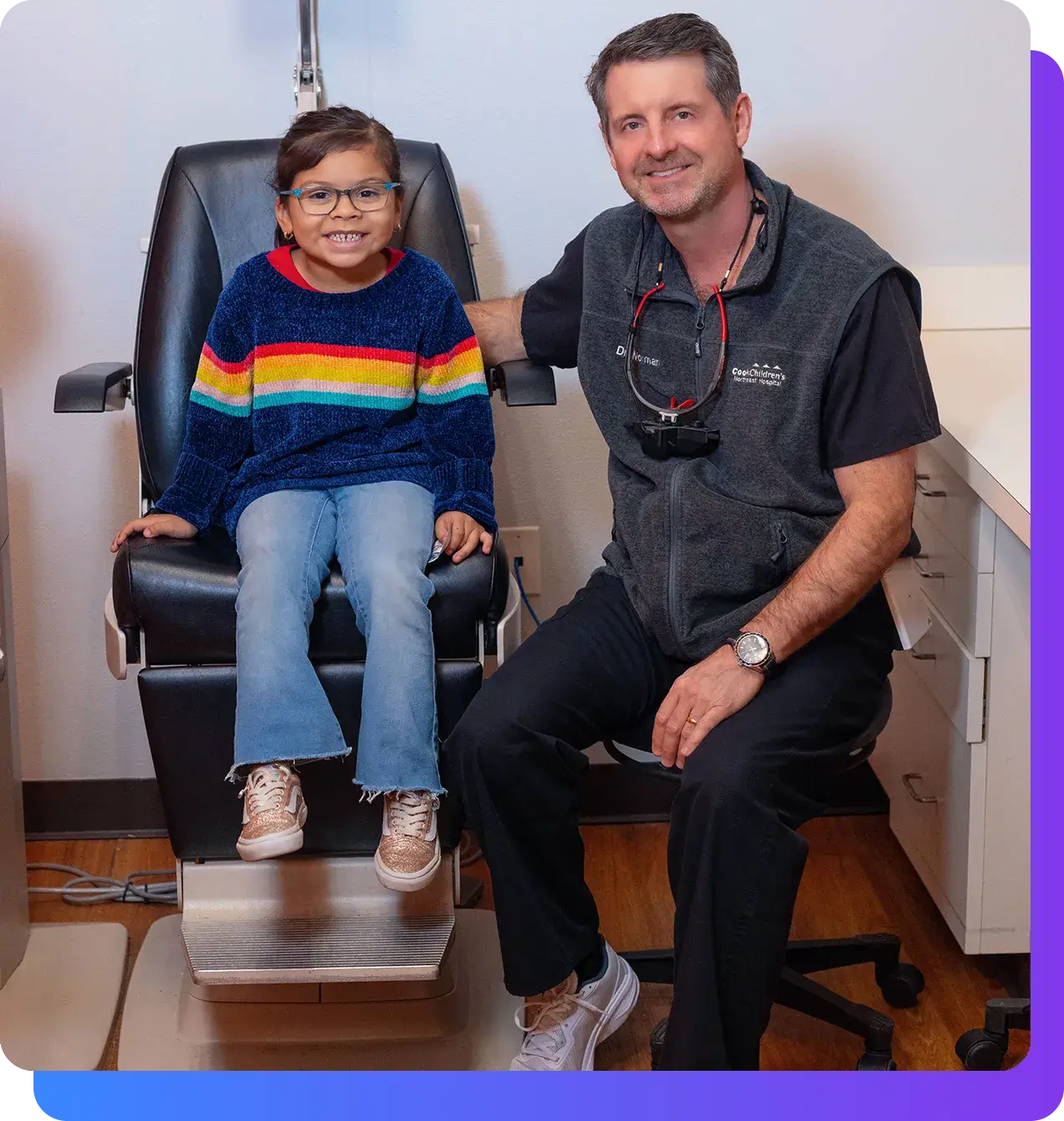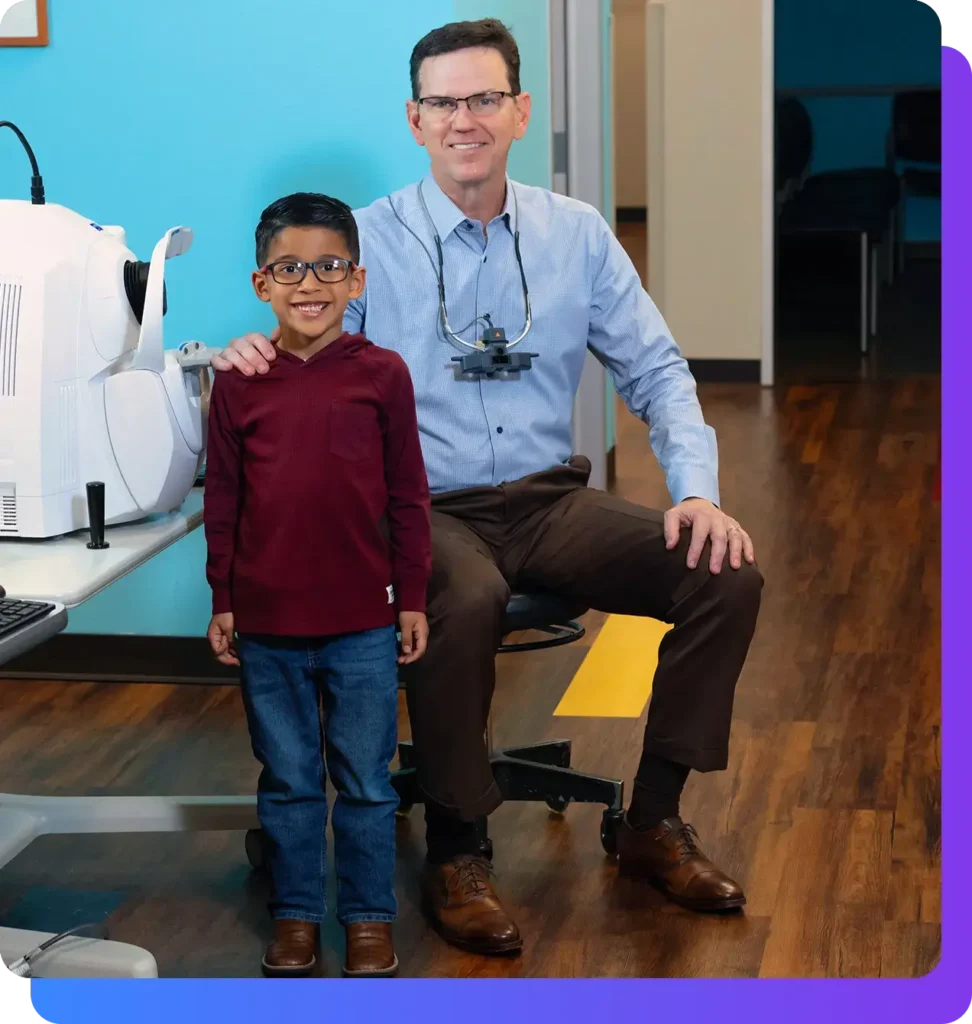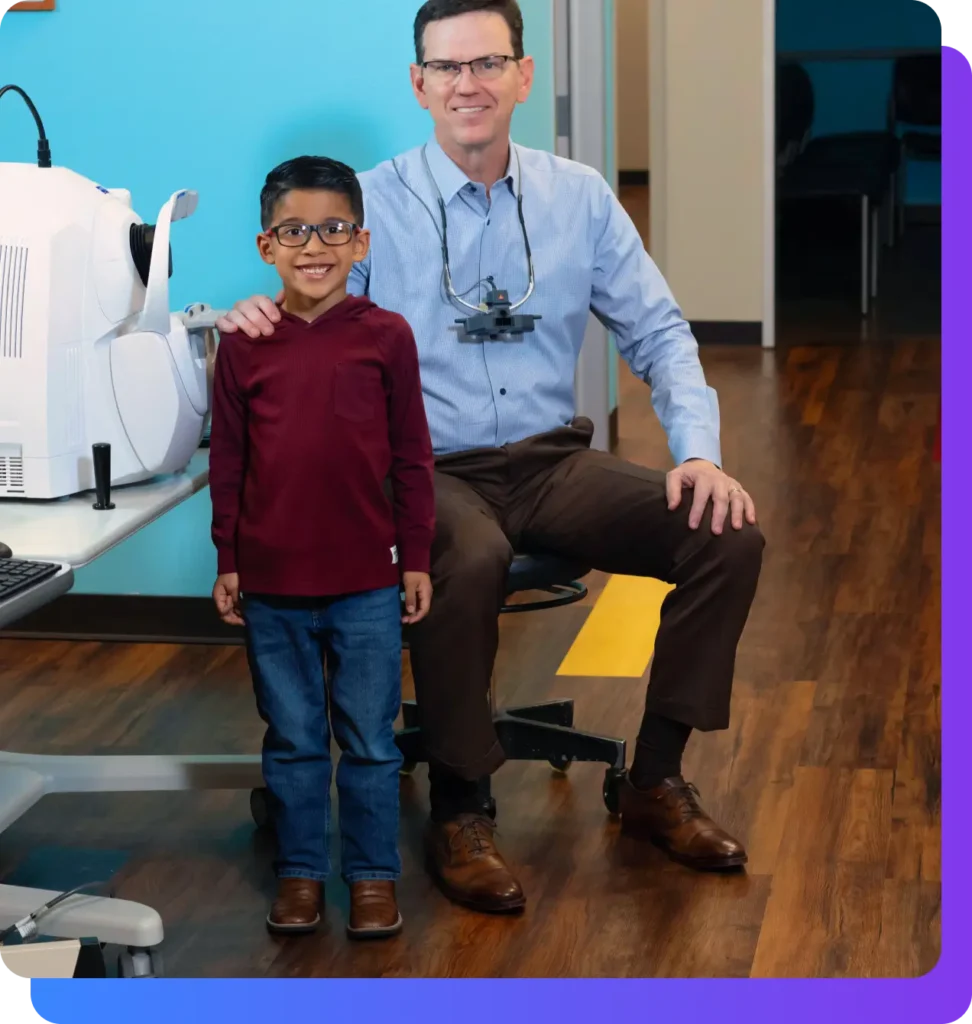Pediatric Ptosis (Droopy Eyelids)
Specialists in North Texas
Learning that your child might have pediatric ptosis, a condition where the upper eyelid droops over the eye, can be concerning for any parent. While pediatric ptosis can be congenital (present at birth) or acquired (develop due to various factors), it’s more than a cosmetic issue. It can impact a child’s visual development and daily activities, potentially leading to other vision problems like amblyopia (lazy eye) if left untreated.
Expert Ptosis Treatments for North Texas
At Pediatric Eye Specialists, we understand your concerns and are committed to providing compassionate and comprehensive care for your child. Our team of experts in pediatric ophthalmology offers precise diagnosis and personalized treatment plans for ptosis. We focus on informing and supporting parents throughout the treatment process, ensuring you feel confident in the care your child receives. We aim to achieve not only the best possible vision for your child but also a high quality of life so they may fully engage with the world around them.

The Basics: What is Pediatric Ptosis?
Pediatric ptosis is a condition characterized by the drooping of one or both upper eyelids in children, which can occur due to a variety of causes ranging from congenital factors to muscle or nerve issues. This drooping may partially or fully obstruct the child’s field of vision, potentially leading to developmental concerns such as amblyopia, commonly known as lazy eye. The severity of ptosis can vary, with some children experiencing only a slight droop while others may have significant eyelid closure. Effective treatment is crucial not only for improving vision but also for ensuring proper visual development as the child grows.
Why Choose Pediatric Eye Specialists for Pediatric Ptosis Treatment
The Most Experienced Team in North Texas
With over sixty-five years of collective pediatric ophthalmology expertise, we offer your child unparalleled collaborative care.
Five Convenient Locations
Easily accessible care with offices in Fort Worth, Denton, Keller, Mansfield, and Prosper.
Unrushed, Clear Communication
We take the time to discuss your child's diagnosis and treatment, ensuring all your questions are answered to ease your concerns.
Affiliated with Cook Children’s Hospital
Our partnership with Cook Children’s Hospital means if your child needs surgery, imaging, or other specialists, they will be treated in one of the nation’s leading pediatric hospitals.
Specialized Expertise
Our expertise means that more optometrists, doctors, and specialists refer their pediatric eye patients to Pediatric Eye Specialists than any other pediatric eye practice in North Texas.
Child and Family Focused
Kids love us, and we love kids! We provide a caring environment for your child and your family.
Advanced Diagnostic Technology
We have the most comprehensive pediatric diagnostic suite in North Texas, allowing for precise diagnosis and highly personalized treatment plans.
Every Child Needs Access to Expert Eye Care
Championing the right to sight, we help navigate insurance, cash pay, and Medicaid options to make superior eye care feasible for all children regardless of their socioeconomic status.

The Benefits of Pediatric Ptosis Treatment
Treating pediatric ptosis early can significantly improve a child’s quality of life and prevent long-term visual and developmental issues.
Success You Can Expect for Your Child
Improved Vision and Eye Health
Treating pediatric ptosis is crucial for maintaining and improving vision and eye health. Correcting ptosis can prevent the development of amblyopia (lazy eye) and ensure proper visual development, which is essential for a child's overall eye health.
Boosted Confidence and Social Interaction
Correcting the drooping eyelid through ptosis treatment can significantly boost a child's self-esteem. Children become more confident in their appearance, which positively impacts their social interactions and ability to engage confidently with their peers.
Enhanced Learning Abilities
Proper vision is key to academic success. By addressing ptosis, we not only improve a child's ability to see clearly but also enhance their focus and ability to engage in educational activities, supporting better learning outcomes.
Prevention of Further Complications
Timely treatment of ptosis can help avoid further eye and vision complications. By addressing the condition early, we can prevent issues like vision impairment or the worsening of ptosis over time.
Cosmetic Improvement
For many children, correcting ptosis can have a positive impact on their psychosocial well-being. This cosmetic improvement can be significant for a child's self-image and confidence, especially as they grow and become more socially aware.
Emotional Well-Being
The psychological benefits of treating ptosis extend beyond the child to the entire family. Knowing that their child is receiving the best possible care for their condition can bring great relief and satisfaction to parents and caregivers.
Long-Term Benefits
Early treatment of pediatric ptosis is not just about immediate results; it's about setting the foundation for lifelong vision health. Effective early treatment can ensure that children enjoy good vision well into adulthood.
Customized Care for Every Child
Each case of ptosis is unique, and so are our treatment plans. At Pediatric Eye Specialists, we tailor our approaches to ensure that each child receives the best possible outcome based on their specific condition and needs.
Holistic Development Support
Treating ptosis is about more than just physical health; it's about supporting the child's overall development and well-being. By ensuring they have the best possible vision, we are also supporting their emotional, social, and academic development.
Real Stories,
Real Smiles.
“They were very good with my nonverbal toddler. It was the best doctor visit experience we have had yet. They were awesome, caring, and quick!.”

Amy Glover
Parent of Patient
“Today, Dr. Packwood saved my youngest from a life of blindness and worked a miracle for my family. I cannot express enough gratitude and thanks for their skillful surgery and expertise. 10 of 10 highly recommend.”

Atticus Lee
Parent of Patient
“The staff here is so amazing with my son. We had such a wonderful experience both at the office and for his surgery! I highly recommend Pediatric Eye Specialists!!!!“

Gianna Stutzman
Parent of Patient
“We are so grateful for the genuine care that Dr. Duff provided for our son Lorenzo, which prevented him from going blind! She is truly a gift to the community.“

JS Cocjin
Parent of Patient
“Professional, compassionate, kind and friendly. They took great care of my preemie baby from Day 1 of ROP. Very happy with how my daughter is progressing and has healthy eyes now.”

Suresh K.C.
Parent of Patient
“We’ve seen Dr. Hunt for the past 6 years since my daughter was 9 days old. We have multiple appointments each year and even eye surgery when she was 1. Our experience here has been fantastic every time and we highly recommend this group!.”

Mandy Edmondson
Parent of Patient
“Dr. Norman has always been very attentive and thorough with my daughter, who has Type 1 Diabetes. The staff are warm and always do their best to be accommodating. I highly recommend Dr. Norman.”

Tricia Moon
Parent of Patient
“Absolutely recommend! All around great experience! They made my son feel comfortable during the visit. Treatment was explained, and I walked out with no questions. I loved it. “

Cynthia Valero
Parent of Patient
“Great staff, great doctors; they know how to help ease kids’ fears and provide excellent service. Had to get my little one in same day for an eye injury, and they found a way to make it happen. Would 100% recommend.“

Kris K
Parent of Patient
Start your child’s journey to better vision today.
Embrace a future of clearer vision and confidence for your child. Contact us now to book your consultation at any of our convenient locations across the Metroplex.
Click to Explore Pediatric Ptosis
Causes of Pediatric Ptosis
Understanding the causes of pediatric ptosis is essential to effective treatment. This condition, characterized by drooping of one or both eyelids, can be due to a variety of factors, each influencing the approach to care.
Genetic Factors
In some cases, ptosis can be hereditary. Genetic conditions like blepharophimosis syndrome or congenital ptosis are passed down through families, affecting the levator palpebrae superioris muscle responsible for lifting the eyelid.
Neurological Disorders
Ptosis may result from neurological conditions that affect nerve function. For instance, Horner’s syndrome, which is caused by the disruption of a nerve pathway from the brain to the face and eyes, can lead to ptosis. Similarly, a cranial nerve disease or third cranial nerve (oculomotor nerve) palsy can manifest as ptosis due to impaired nerve control of eyelid muscles.
Muscle Weakness or Dysfunction
Conditions like myasthenia gravis, characterized by weakness in the skeletal muscles, can cause ptosis. This autoimmune neuromuscular disorder specifically affects the muscles that control eye movement and eyelid elevation.
Eyelid Tumors or Swelling
In rare cases, neoplasms (tumors) or swelling in or around the eyelid, like in chalazion or edema, can lead to mechanical ptosis. These conditions can cause physical obstruction or weigh down the eyelid.
Birth Defects
Congenital ptosis is present at birth and can be due to developmental issues with the muscles that lift the eyelid. It’s often associated with other eye-related birth defects.
Trauma or Injury
Injuries to the eye or eyelid, including those affecting the nerve or muscle tissue, can result in ptosis. This could be due to trauma or a complication of eye surgery.
Syndromic Causes
Ptosis can be a component of broader syndromes like Noonan syndrome or congenital myasthenic syndrome, where it is one of several symptoms caused by a more complex genetic condition.
Refractive Errors and Eye Strain
Although less common, significant uncorrected refractive errors, like severe astigmatism, can sometimes result from ptosis. The resulting blur can cause amblyopia.
In pediatric ptosis, each of these causes necessitates a different approach to diagnosis and treatment. At Pediatric Eye Specialists, we conduct a comprehensive eye examination, including a detailed medical history and neurological examination, to determine the underlying cause of ptosis. This thorough evaluation ensures a tailored treatment plan that addresses the specific needs of each child. Understanding these causes helps in guiding parents and children through the journey of managing and treating this condition, supporting their overall health and well-being.
Understanding these causes is vital for Pediatric Eye Specialists in diagnosing and formulating an effective treatment plan for ptosis.
Types of Pediatric Ptosis
Pediatric ptosis, or the drooping of the upper eyelid in children, can present in various forms. Understanding these types is crucial for accurate diagnosis and appropriate treatment. Let’s explore the different types of pediatric ptosis:
Congenital Ptosis
This type is present at birth and is one of the most common forms of ptosis in children. Congenital ptosis is often caused by poor development of the levator palpebrae superioris muscle, the muscle responsible for lifting the eyelid. It may affect one or both eyelids and can vary in severity. Children with congenital ptosis might also exhibit a chin-up head posture to see better.
Acquired Ptosis
Unlike congenital ptosis, acquired ptosis develops after birth and can be due to a variety of causes, such as neurological disorders, trauma, or systemic diseases. For instance, a nerve injury affecting the oculomotor nerve can lead to acquired ptosis.
Neurogenic Ptosis
This type results from a problem with the nerves controlling the eyelid muscles. Conditions like Horner’s syndrome or third cranial nerve palsy can cause neurogenic ptosis. It’s often accompanied by other neurological symptoms, making a comprehensive neurologic assessment essential.
Myogenic Ptosis
Caused by muscle-related issues, myogenic ptosis can be due to muscular dystrophies or conditions like myasthenia gravis. In these cases, the muscle itself is weakened or fatigued, leading to drooping eyelids.
Mechanical Ptosis
This occurs when the eyelid is weighed down by an external factor, such as swelling, tumors, or scarring. For example, a large chalazion (eyelid cyst) can cause mechanical ptosis.
Aponeurotic Ptosis
Often seen in older children and adults, this type is caused by the stretching or thinning of the tendon-like tissue that connects the levator muscle to the eyelid. It’s usually associated with aging, but can sometimes occur in children due to eye rubbing.
Traumatic Ptosis
Resulting from injury to the eyelid or its associated nerves and muscles, traumatic ptosis can occur after accidents or surgical procedures. It may be temporary or permanent, depending on the extent of the damage.
Syndromic Ptosis
In some cases, ptosis is part of a broader syndrome with multiple symptoms, such as blepharophimosis-ptosis-epicanthus inversus syndrome (BPES). Identifying syndromic ptosis is crucial for comprehensive care, as it may involve other systemic issues.
At Pediatric Eye Specialists, we carefully assess each case of ptosis, considering the child’s age, the severity of the droop, and any associated symptoms. This helps us determine the type of ptosis and create a personalized treatment plan. Understanding the type of ptosis ensures that each child receives the most effective care for their specific condition.
Signs and Symptoms of Pediatric Ptosis
Identifying the signs and symptoms of pediatric ptosis is crucial for early detection and treatment. Parents and caregivers should be aware of the key indicators and associated symptoms to ensure timely medical intervention. Here are the common signs and symptoms of pediatric ptosis:
Drooping Eyelid(s)
The most obvious sign of ptosis is one or both eyelids appearing noticeably lower than normal. The droop can range from mild, where the eyelid only slightly covers the pupil, to severe, where the eyelid can cover a significant portion of the eye.
Asymmetrical Eye Appearance
In unilateral ptosis, where only one eyelid is affected, there may be a noticeable asymmetry in the child’s eye appearance. One eye may look different in size or shape compared to the other.
Tilting the Head Back or Chin-Up Position
Children with ptosis often adopt a head-tilting or chin-up posture to see more clearly. This compensatory mechanism helps them lift the drooping eyelid and improve their field of vision.
Eyebrow Raising
You may notice your child frequently raising their eyebrows. This is an involuntary attempt to raise the drooping eyelid and can be more pronounced when the child is trying to focus on something.
Difficulty with Vision
Ptosis can lead to visual impairment, especially if the eyelid obstructs the pupil. Children might have problems with tasks that require clear vision, like reading or catching a ball.
Eye Fatigue or Strain
Due to the effort required to lift the eyelid and compensate for reduced vision, children with ptosis may often complain of eye fatigue or strain.
Eye Movement Limitations
In some cases of ptosis, especially where there is nerve or muscle involvement, there may be limitations in eye movement or a noticeable difference in how each eye moves.
Amblyopia (Lazy Eye)
If ptosis is present in early childhood, it can lead to the development of amblyopia, where the affected eye doesn’t develop normal vision. This can occur if the drooping eyelid constantly covers the pupil during crucial developmental stages.
Frequent Blinking or Eye Rubbing
Children with ptosis may blink more often or rub their eyes in an attempt to clear their vision or manage discomfort associated with the condition.
Sensitivity to Light
Some children with ptosis may exhibit photophobia, or light sensitivity, which can cause discomfort in bright environments.
Still Have Questions?
Recognizing these signs and symptoms is key to early diagnosis and treatment of pediatric ptosis. If you notice any of these indicators in your child, it’s important to schedule an appointment with Pediatric Eye Specialists. Our team is adept at diagnosing and treating ptosis, ensuring your child receives the best possible care to improve their vision and quality of life.
Diagnosing Pediatric Ptosis: A Comprehensive Approach
The diagnosis of pediatric ptosis is a meticulous process that Pediatric Eye Specialists undertakes with precision and care. It involves a combination of a clinical examination and, when necessary, advanced imaging techniques. Here’s how the diagnostic journey unfolds:
Clinical Eye Examination
The initial step in diagnosing ptosis is a thorough eye examination. Pediatric Eye Specialists assesses the degree of eyelid drooping, the strength of the eyelid muscles, and the child’s ability to move their eyelids. This examination also includes evaluating eye movements and the pupils, as changes in these areas can be indicative of underlying nerve involvement.
Measurement of Eyelid Position
Precise measurements are taken to determine the extent of the eyelid droop. This includes evaluating the eyelid’s position in relation to the pupil and measuring the height of the eyelid crease, which can provide insights into the type of ptosis and its severity.
Assessment of Eye Movements
Observing the child’s eye movements helps in identifying any associated conditions like strabismus (misaligned eyes) or amblyopia (lazy eye). It also helps in ruling out any neurological causes of ptosis that might affect eye muscle function.
Visual Acuity Test
Testing the child’s visual acuity is crucial to determine if ptosis has affected their vision. This helps in identifying any refractive errors like nearsightedness or astigmatism that might be present alongside ptosis.
External Eye Examination
Pediatric Eye Specialists conducts a detailed external examination of the eyes and eyelids. This includes checking the skin texture, looking for any signs of swelling or masses, and assessing the eyebrow position, which can sometimes compensate for eyelid drooping.
Slit Lamp Examination
Using a slit lamp, the doctors examine the eyes’ anterior (front) segment, including the cornea, iris, and lens. This is crucial to rule out any other eye conditions that might coexist with ptosis.
Imaging Tests
In some cases, imaging tests like an MRI or CT scan may be recommended. These tests are particularly useful if there is a suspicion of an underlying neurological or structural cause, such as a tumor or nerve disorder, contributing to the ptosis.
Neurological Evaluation
If the ptosis is suspected to be due to a neurological condition, a detailed neurological examination might be necessary. This could involve assessing cranial nerve function and muscle strength.
Family and Medical History Review
A review of the child’s medical history and family history is essential. This helps in identifying any genetic patterns or systemic health issues that might be linked to the development of ptosis.
Observation of Lid Function
Pediatric Eye Specialists observes the functionality of the lid, such as how the lid moves when the child looks up or down, which can provide clues about the underlying cause of ptosis.
Through this comprehensive diagnostic process, Pediatric Eye Specialists can accurately identify the type and cause of ptosis, paving the way for an effective treatment plan. Early diagnosis is key in managing pediatric ptosis effectively, ensuring the best possible outcomes for the child’s vision and overall eye health. If you suspect your child has ptosis, it’s important to seek a consultation with our specialists, who are equipped to provide a thorough evaluation and the highest standard of pediatric eye care.
Treatments for Pediatric Ptosis: Comprehensive and Individualized Approaches
Treating pediatric ptosis at Pediatric Eye Specialists involves a blend of surgical and nonsurgical methods, tailored to each child’s specific condition and needs. Our goal is to not only correct the drooping eyelid but also to address any associated visual impairments and enhance the child’s overall quality of life. Here’s a closer look at the treatment options available:
Nonsurgical Treatments:
Observation: In mild cases of ptosis, especially if the vision is not affected, our approach may start with close observation to monitor any changes or progression.
Glasses with Special Lenses: For children whose ptosis is accompanied by refractive errors, corrective glasses can sometimes help. In rare cases, glasses equipped with a ptosis crutch, a device attached to the glasses that helps hold the eyelid up, can be an effective nonsurgical solution.
Eye Patches: When ptosis leads to amblyopia (lazy eye), patching the stronger eye can encourage use of the weaker eye, thereby improving vision.
Surgical Treatments:
Levator Muscle Surgery: The most common surgical treatment for ptosis involves tightening the levator muscle, which lifts the eyelid. This procedure is tailored based on the muscle’s strength and the degree of ptosis.
Frontalis Sling Surgery: In cases where the levator muscle is very weak, a frontalis sling procedure may be used. This involves connecting the eyelid to the forehead muscles, allowing the brow muscles to lift the eyelid.
Müller’s Muscle-Conjunctival Resection: This less invasive surgery is an option for mild to moderate ptosis and involves tightening Müller’s muscle, a secondary eyelid lifting muscle.
Customized Approach for Each Child:
Every child’s case of ptosis is unique, and treatment plans are customized accordingly. Factors like the age of the child, severity of ptosis, underlying causes, and the presence of other eye conditions play a crucial role in determining the most suitable treatment.
Postsurgical Care and Follow-up:
Postoperative care is critical for successful outcomes. This includes regular follow-up visits to monitor healing, assess the effectiveness of the surgery, and make any necessary adjustments.
We also provide guidance on postoperative care at home, including instructions on how to care for the surgical site, manage discomfort, and recognize signs of any potential complications.
At Pediatric Eye Specialists, we are committed to providing each child with the most effective, safe, and appropriate treatment for their pediatric ptosis. Our approach is not just about the physical correction of ptosis but also about ensuring the best possible visual and emotional outcomes for our young patients and their families. If you have concerns about your child’s eyelid drooping, we encourage you to schedule a consultation with our expert team for a comprehensive evaluation and personalized treatment plan.
Our commitment at Pediatric Eye Specialists is to provide your child with the highest standard of care, combining medical expertise with compassion and understanding.
Typical Expected Outcomes: Realistic and Hopeful Prognosis after Pediatric Ptosis Treatment
Navigating the journey of pediatric ptosis treatment can be filled with uncertainties, but understanding the typical outcomes can provide reassurance to parents. At Pediatric Eye Specialists, our focus is on achieving the best possible results for each child, taking into account the unique aspects of their condition. Here’s what parents can generally expect following treatment for pediatric ptosis:
Improved Eyelid Position and Function
The most immediate and noticeable outcome is often the correction of the drooping eyelid. Surgical treatments, in particular, aim to restore the eyelid to a more natural position, enhancing both appearance and function.
Enhanced Visual Development
Successful treatment of ptosis, especially when addressed early, plays a crucial role in a child’s visual development. Correcting the eyelid position can prevent or mitigate the risk of amblyopia (lazy eye) and other visual impairments.
Increased Comfort and Reduced Symptoms
Children often experience relief from symptoms associated with ptosis, such as eye strain, blurred vision, or the need to tilt their head for better sight. This can lead to greater comfort in everyday activities.
Better Quality of Life
With improved vision and eyelid function, children often enjoy a higher quality of life. They may find it easier to participate in sports, read, and engage in other activities that require clear vision.
Ongoing Monitoring for Long-Term Success
While the initial outcomes are often positive, long-term success depends on regular follow-up care. This allows our specialists to monitor the child’s progress, make any necessary adjustments, and ensure the continued effectiveness of the treatment.
It’s important for parents to have realistic expectations. While treatment aims for the best possible outcomes, every child’s situation is unique, and results can vary. Some children may require additional treatments or long-term management.
Secure a Brighter Future: Schedule a Pediatric Ptosis Consultation Today
Discover the pathway to your child’s enhanced vision and well-being with Pediatric Eye Specialists. Embrace this opportunity for expert care and witness the transformation in your child’s life. Our dedicated team, renowned for successfully treating pediatric ptosis, is committed to guiding you towards the most positive outcomes. Let us be your partners in nurturing your child’s vision and confidence. Don’t wait—schedule your consultation today and take the first step towards a brighter, clearer future for your child.

Start your child’s journey to better vision today.
Embrace a future of clearer vision and confidence for your child. Contact us now to book your consultation at any of our convenient locations across the Metroplex.
What is the youngest age at which pediatric ptosis can be safely treated?
Parents often wonder about the appropriate age for ptosis treatment. At Pediatric Eye Specialists, we assess each case individually, considering factors like the child’s overall health and the severity of the ptosis. In some instances, treatment can be safely performed in infancy, especially if the ptosis is severe and obstructing vision.
Can pediatric ptosis recur after treatment?
While treatment for ptosis, particularly surgery, is generally successful, there can be cases where ptosis recurs, especially if it’s related to an underlying condition. Our team closely monitors each child post-treatment to manage any such occurrences effectively.
Are there any lifestyle changes we can make to help manage my child’s ptosis?
Lifestyle changes alone can’t correct ptosis, but certain practices can help manage the condition. We recommend avoiding activities that may strain the eyes and ensuring your child has regular breaks during visually intensive tasks. Our team can provide personalized advice based on your child’s specific condition.
How can I explain ptosis to my child to help them understand their condition?
Explaining medical conditions to children can be challenging. We suggest using simple terms, like explaining that their eyelid muscles aren’t as strong as they should be, making their eyelid droopy. Our specialists can help provide age-appropriate explanations during your visit.
Will my child need to take time off school for ptosis treatment?
The amount of time off required depends on the type of treatment. For nonsurgical treatments, little to no time off may be needed. However, if surgery is performed, your child may need to rest at home for a few days to a week. Our team will provide detailed guidance on what to expect after treatment.
How does pediatric ptosis affect visual perception, and can it lead to long-term issues?
Pediatric ptosis can sometimes obscure the visual field, impacting a child’s ability to perceive the world around them accurately. If left untreated, it can lead to developmental vision problems. Our health care providers specialize in detecting and addressing any issues early to support the child’s visual and neurological development.
What is the relationship between ptosis and neurological health in children?
Ptosis can sometimes be a sign of underlying neurological conditions, especially if associated with oculomotor nerve palsy or other cranial nerve involvements. Our neurology partners can work closely with Pediatric Eye Specialists to evaluate and treat any neurological factors contributing to a child’s ptosis.
Can ptosis be related to conditions that affect the neck or other areas of the nervous system?
While ptosis primarily affects the eyelids, it can occasionally be related to broader health care concerns, including issues that affect the neck or nervous system. Comprehensive evaluations often include assessing muscle contraction and nerve function to rule out systemic conditions.
Is ptosis surgery always performed by an ophthalmologist, or are there cases where a surgeon from another specialty is needed?
Ptosis surgery is typically performed by an ophthalmologist, particularly a pediatric ophthalmologist if the patient is a child. However, in complex cases, a multidisciplinary team including an oculoplastic surgeon may be involved.
What role do the extraocular muscles play in pediatric ptosis, and how is this addressed in treatment?
The extraocular muscles (the muscles that control eye movement and positioning of the eyeball) are responsible for eyelid movement and can be the source of ptosis if there’s a myogenic mechanism issue. Treatments may include therapies to strengthen muscle contraction or surgery to correct the position of the eyelid. Our specialists in pediatric ophthalmology and neurology are skilled in diagnosing and treating such complexities.
How does pediatric ptosis affect the function of the human eye, and can it be corrected?
Pediatric ptosis affects the human eye by potentially impeding the upper field of vision due to the drooping eyelid. This can interfere with the normal functioning of the eye, including limiting the full range of vision and the ability to form proper visual images. With appropriate treatment, which may include surgery, medical interventions, or special glasses, the condition can often be corrected, allowing the eye to function normally.